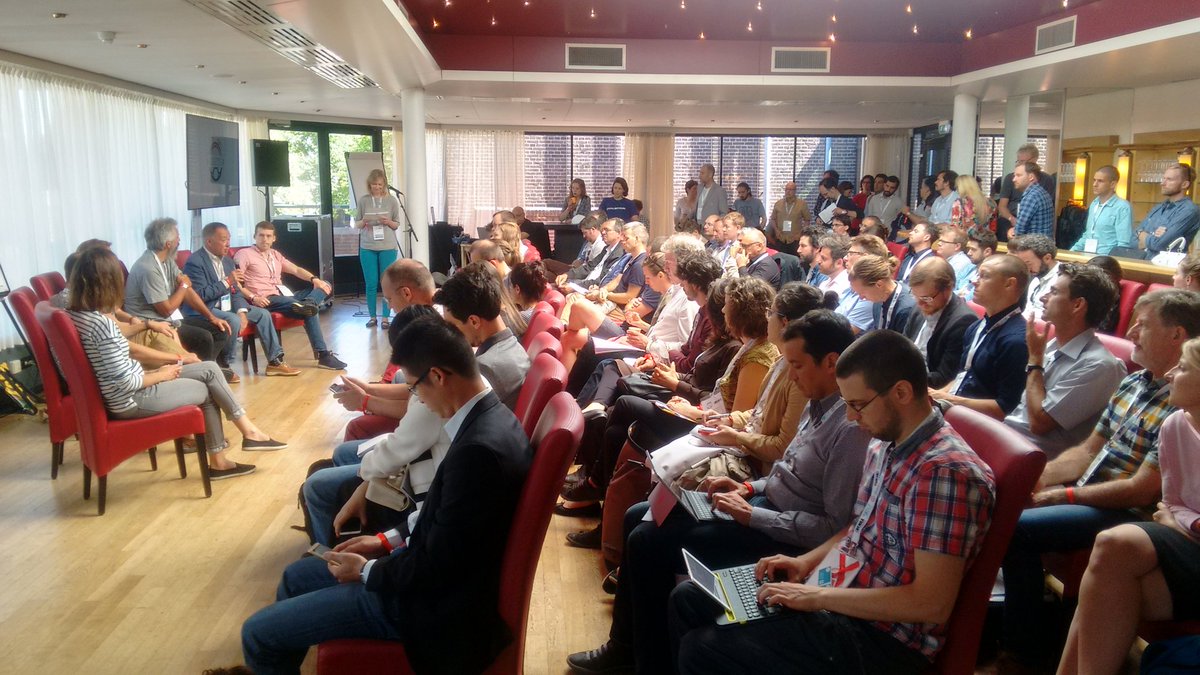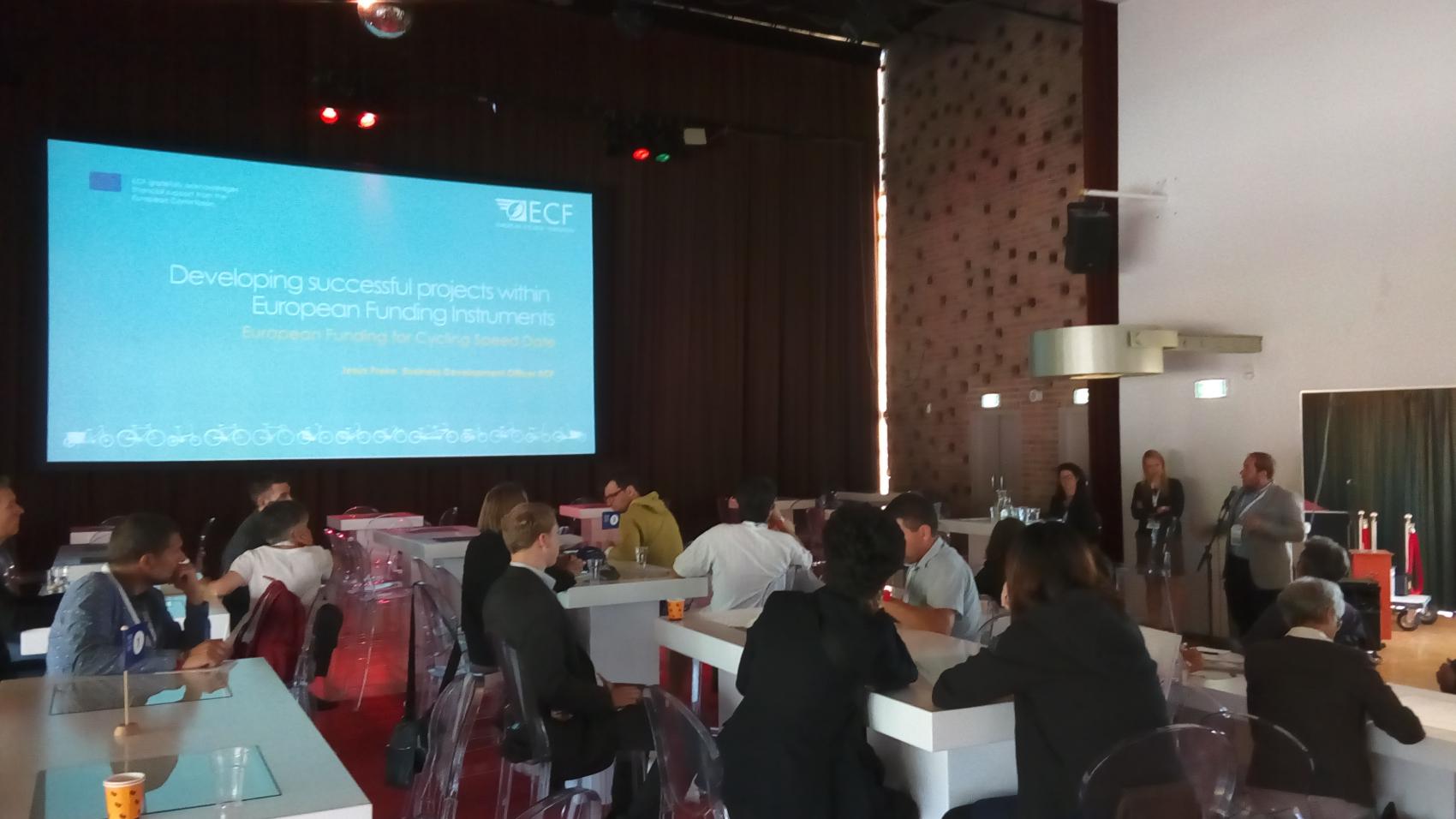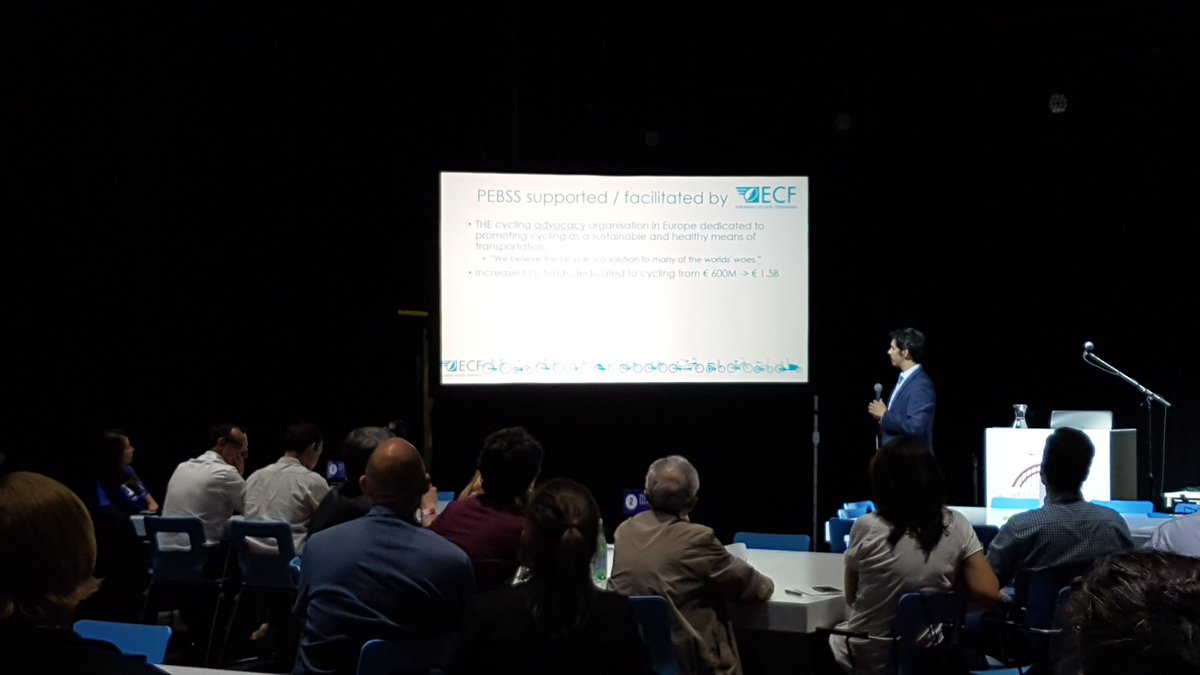
Day 02 at Velo-city 2017 [14th June]
Day 01 Highlights here!
Bikenomics
Let’s talk Cycling Economics. We need to “set the frame for the sustainable world that we want and above all avoid unsustainable development”, said Manfred Neun, ECF president this morning in Nijmegen, NL. He called for a level playing field with regards to cycling, the use of public space, and development. “It’s our goal to communicate the economic benefits of cycling better, because they deserve more attention” said Neun. He quoted Ms Martha Roskowski who spoke on the same stage on Tuesday “There is a regrettable legacy of aligning & designing transport projects that separated Americans along economic and even racial lines.” Neun insisted that we must change from the normal business as usual (BAU).
Manilla, in the Philippines suffers losses equivalent to 6.4% of Gross Domestic Product (GDP) per year due to congestion, reported Ms Julia Nebrija of the Metro Manila Development Authority. “People are commuting 3-4 hours per day. Although there is a small percentage of private car owners in Manilla, 80% of the road space is dedicated to car use.” "A bicycle is the vehicle to opportunity", she said, speaking of the many people who have few or no options to participate meaningfully in society. She has been working to reclaim the public space for bike lanes, for sidewalks, for park space, space for people. Her message was very well received by the near capacity audience, at least judging by the minutes-long ovation she received.
In 1979 the 4th King of Bhutan was asked by a reporter about GDP of his country. As befits a King of 1 million people living in a mountainous country the size of the Netherlands, he knew how to put things into context. “Gross National Happiness is more important the GDP”, Mr Namgyel Chief Environment Officer for the Royal Government of Bhutan said. He retired in 2006, but the concept of Gross National Happiness or GNH has become part of the federal government. Thinley Namgyel told about 1000 Velo-city delegates that “Gross National Happiness is part of my daily work as a planner.” He explained that the government consider its policy for the impact not only on Gross Domestic Product, but also on GNH. In this respect, the people of Bhutan have been led by generations of Kings who ride bikes.
Neurologist Bastiaan Bloem Professor at Radboud University Medical Centre, reported that cycling is less affected than other motor activity for Parkinson patients. He has worked with a number of patients who cannot walk, but who can cycle. His 10 minutes of fame came when the New England Journal of Medicine and the New York Times reported on this. “It’s a story of hope – some people cannot walk, but they can still ride a bicycle.” His research in the field identified that “the single question “can you ride a bike” obviated all the needs for all the other very expensive tests” to identify Parkinson disease (Aerts ea., Lancet 2011 377: 125-126 : ”The bicycle sign for atypical parkinsonism”). Professor Bloem said that we all have “The right to wind in your hair”. Cycling Without Age is a movement started in 2012 to help the elderly get back on their bicycles. From their website: “We dream of creating a world together, in which the access to active citizenship creates happiness among our fellow elderly citizens by providing them with an opportunity to remain an active part of society and the local’
Written by: Dr Randy Rzewnicki, Health Policy Officer
Extending the Reach: Combining Bicycle and Train

Public transport operators that fully integrate cycling into their system enlarge their catchment area and hereby attract new customers. Combining cycling with public transport is an effective measure in getting people out of cars.
Bram Nieuwstraten of Amsterdam Vervoersregio reported impressive results of the first BRT line that was introduced in 2002 operating busses from Haarlem to Amsterdam. Replacing an existing conventional bus line with now much fewer stops, bicycle parking was installed at the bus stops to address the issue that customers now had to travel longer distances to the bus stations. His figures showed that people are willing to walk 500m to traditional public transport services and 700m to high-end public transport services; with cycling that figure increases to 1,900m. In order to cope with demand, the number of bike parking had to be upgraded 4 times since the BRT service was put into service 15 years ago.
However, simply providing bike parking and customers will come does not necessarily need to work. Claudia Ramirez from Steer Davies Gleave reported about Rio de Janeiro’s public transport operator attempt of attracting new customers by building 4,000 bike parking places at 6 commuter railway stations. Although the service was free of charge, the bike stations remained largely empty due to a poor level of service. You need to know your potential customer’s need and address them in the simplest possible way was her central message.
Bruno van Zeebroek from Transport & Mobility Leuven reported about the 6 Building Blocks that were identified within the EU funded BiTiBi project to better combine cycling with railway services. The project partners such as BlueBike from the Belgian railway company reported a substantial increase in the use of its bike-sharing scheme. If the measures recommended were implemented across Europe, railway companies could see as much as 250 million more trips in 2030, resulting in 5 billion fewer pkm driven by car. Every Euro invested in bicycle facilities does unlock 4 Euro’s in benefits, he concluded.
Written by: Fabian Kuester, Senior Policy Officer
European Funding for Cycling- Speed Date
More than 30 participants attended the interesting networking session organized by ECF for people, organizations and public bodies interested in EU funds for cycling projects. The speed date aimed at guiding participants towards the most suitable funding opportunities at European, national and regional level for cycling projects, by providing funding experts, project partners and funding bodies with the opportunity to meet and exchange best practices and experiences and to explore opportunities for cooperation.
 In the last years the level of EU funds dedicated to cycling increased. More European resources for cycling projects could be raised through a better shared knowledge of funding opportunities and exchange of experiences. In most cases, organizations have access to EU funds by applying to centralized calls for proposals, but many other ways exist to get projects funded: regional development funds, financial support from European programmes and many other instruments to promote cooperation among countries can and should be exploited more.
In the last years the level of EU funds dedicated to cycling increased. More European resources for cycling projects could be raised through a better shared knowledge of funding opportunities and exchange of experiences. In most cases, organizations have access to EU funds by applying to centralized calls for proposals, but many other ways exist to get projects funded: regional development funds, financial support from European programmes and many other instruments to promote cooperation among countries can and should be exploited more.
Despite the fact that there are only a few programmes directly allocating funds to cycling, applying for cycling-related projects is extremely important, said Ms Carolien Ruebens, project manager at ECF and session moderator. The EU funds Cycling Observatory, developed by ECF two years ago, offers a wide overview on EU funding instruments in which cycling is addressed and a total of 1.5 billion euro could potentially be allocated to cycling initiatives. ECF is extremely active in supporting members, networks and organisations to submit project proposals and is also an experienced project partner.
The process from project idea to implementation requires expertise and planning skills that ECF developed over many years. In the last five years, ECF has been involved in several EU funded initiatives for a total value of € 28 million, explained Mr Jesus Freire, business development officer at ECF, who also showed some successful project applications that were funded such as the FLOW and CHIPS project and the EuroVelo-related projects. Last but not least, sustainability is one of the main aspect in both designing and implementing a successful project, continued Mr Freire.
Over the last decade ECF improved its expertise and we count 25 experts nowadays on different topics such as designing and promoting European standards for infrastructure and cycle-friendly companies. Thanks to its wide networks, ECF has a sound experience on dissemination and promotion of project outcomes and results. Contact ECF if we can help you to develop and deliver your European funded project!

From paper to reality: there are so many obstacles in project implementation. Clarifying goals and define responsibilities within the consortium is the first step, highlighted Ms Magalie Van Lishout, project manager at Province of Flemish Brabant. Another important step is cooperation: the advantage of involving project partners allows useful peer reviews, fulfills deadlines and milestones and long-lasting synergies that run beyond the project lifetime.
Getting a project funded is not easy: high competition and limited funds impose high quality proposal for a positive evaluation. Many instruments are available at European level. Especially for small and medium enterprises there are many ways to get their project financed, outlined Mr Olivier Kozak, Senior Advisor at EASME, the European Executive Agency for SMEs.
Mr Kozak explained how a public institution can be an accelerator for growth and how the SME Instrument can support SMEs in 3 phases:
- Financial support to develop an innovative product;
- Financial support to the production;
- Commercialization and business community: the EU contribution help boosting visibility and partnership and being ready to face the market.
More than 30 participants joined the speed date to exchange ideas, information and expertise. Small groups of people had a very fruitful discussion, guided by the speakers and the moderator before moving to another table.
Written by: Marco Ciarrocchi, Project Officer
Launching PEBSS, the new Forum for Shared Bicycle (Knowledge)
After the successful inaugural conference on Monday, another session was dedicated to the launch of ECF’s new Platform for European Bicycle Sharing & Systems (PEBSS) today. The platform is open to operators offering any form of smart, shared access to a bike, whether public, private or hybrid. It is connected to ECF’s work on smart cycling, which aims to move cycling innovation into the policy mainstream and attract political support for new investments. Two of the platform’s main objectives are to integrate bike sharing into all public and private urban mobility and to leverage global best practices.
Following the presentation of the platform, five bike sharing stakeholders from all around the globe gave short introductions to their companies and projects:

- BiciMAD: The Madrid bike sharing system has been introduced in 2014, integrated in the municipality’s public transport enterprise. Utilisation rates have increased since the introduction of the system, also due to accompanying awareness raising campaigns for cycling, restrictions on car access to the city centre and the improvement of cycling infrastructure.
- Donkey Republic: This global bike rental system provides bikes in cities around the world using a smartphone app and a geo-localisation system. The company works together with city governments to avoid negative impacts on public space and puts great efforts in maintaining their simple yet comfortable bikes.
- NABSA: The North American Bike Share Association represents the main actors in the field in the US and Canada. It has developed a code of conduct for free-floating bike share systems, which includes provisions on safety, maintenance, cooperation with cities, transparency, equity and customer focus.
- Nextbike: This German company with 13 years of experience in bike share is now active on 4 continents with more than 40 000 bikes. They work in all fields related to bike share, including research and development of new bikes and technologies. Offering tailored solutions for the needs of each city, they are confident that PEBSS will establish a good policy framework for public bike sharing.
- Smoove: By partnering with big players in the bike share business, this company managed to win the framework contract for the Paris bike share system. They offer innovative bikes and solutions to problems like station overflow, including e-bikes which will make up 30% of the bike fleet in the French capital.
In his concluding remarks, ECF President Manfred Neun stressed the need for fair competition and the integration with public transport and called the launch of the PEBSS one of the main takeaways of this year’s Velo-city conference.
Written by: Holger Haubold, Fiscal and Economic Policy Officer
Best Dutch Cycling Cities
Cycling in the Netherlands seems so natural as if it has always been that way. In reality, it takes courage and bold choices to systematically improve the quality of cycling. In this session different cities explained how they made the switch from car-driven cities to bicycle-driven cities and how you can develop new neighbourhoods with the bicycle as main mode of transport.
Nancy van der Bol, bicycle-policy advisor for the city of Amsterdam, and Paul van den Bosch, Team manager Planning and Research at Dutch consultancy firm DTV Consultants, discussed the cycle routes in Amsterdam and the cost-benefit appraisal tool. In Amsterdam 78 % of the population owns a bike, which translates to 1.9 bikes per household! 665, 0000 trips are made by bike daily. The average speed is 30 km/h on 90% of the roads in the city, making Amsterdam both safe and comfortable.
Paul de Rook, Vice mayor for traffic Groningen, explains how green light cycle is a very effective way to manage transport - all cyclists at same junction have the green light at the same time. All the other modes of transport have a red light. Therefore, no interaction between cars and cyclists actually happens. This gives shared space to only cyclists and it promotes self-learning. Bas Braakman, Eindhoven traffic planner and bicycle policy advisor, says that inhabitants are still quite car orientated, but the Ebikes are important to the city. Attractive healthy city is more important than a cycling paradise. Jan-Albert de Leur heerhugowaard says that the first step is to free cars from the city centre.
Written by: Ceri Woolsgrove, Road Safety and Technical Policy Officer
Regions:
Network/Project Involved:
Contact the author
Recent news!
Upcoming events
Contact Us
Avenue des Arts, 7-8
Postal address: Rue de la Charité, 22
1210 Brussels, Belgium









